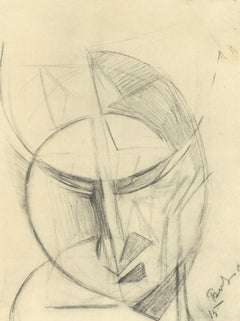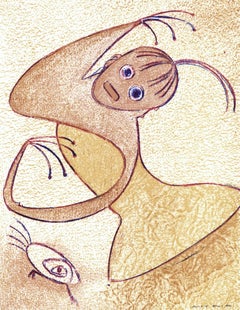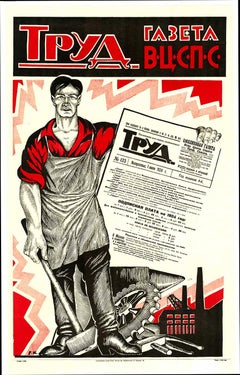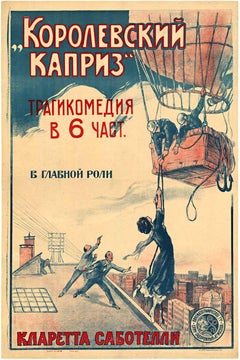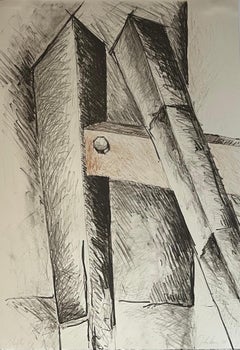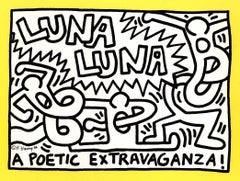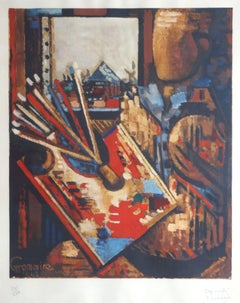Constructivist Figurative Prints
to
2
2
3
4
1
2
Overall Width
to
Overall Height
to
15,572
8,001
2,620
2,435
2,253
1,000
944
735
667
408
323
112
93
37
1
1
1
1
1
12
5
1
2
2
2
10
2
10
7
6
5
5
3
3
2
2
2
1
1
1
1
1
1
1
8
2
2
2
10
2
Style: Constructivist
Antoine Pevsner, Head of a Woman, from XXe siecle, 1959
Located in Southampton, NY
This exquisite lithograph by Antoine Pevsner (1886–1962), titled Tete de femme (Head of a Woman), from the album XXe siecle, Nouvelle serie, XXIe Annee, No. 12, Mai-Juin 1959, origin...
Category
1950s Constructivist Figurative Prints
Materials
Lithograph
$716 Sale Price
20% Off
Max Ernst, Homage to San Lazzaro, from San Lazzaro et ses Amis, 1975
By Max Ernst
Located in Southampton, NY
This exquisite lithograph by Max Ernst (1891–1976), titled Hommage a San Lazzaro (Homage to San Lazzaro), from the album San Lazzaro et ses Amis, Hommage au fondateur de la revue XXe...
Category
1970s Constructivist Figurative Prints
Materials
Lithograph
$956 Sale Price
20% Off
Original Newspaper Labor "Gazeta Trud" 1924 Russian vintage constructionist
Located in Spokane, WA
Original 1924 poster. A Russian man holding a newspaper, reading "Labor". This is for the Communist National Center Party. Linen-backed. Original. Excellent condition. Artist initi...
Category
1920s Constructivist Figurative Prints
Materials
Lithograph
Original Congresso di Parigi vintage political poster
Located in Spokane, WA
Original Congresso di Parigi vintage poster, linen backed. Cogresso di Parigi Anti Sovient Propaganda original vintage poster. Very fine condition with only slight surface wear....
Category
1950s Constructivist Figurative Prints
Materials
Offset
Original King of Caprice vintage Russian silent movie lithographic poster
Located in Spokane, WA
Original silent movie poster: King of Caprice (translated from Russian.). Archivally linen-acked in very good condition. Images shown are of the exac...
Category
1920s Constructivist Figurative Prints
Materials
Lithograph
Shafts, lithograph, pencil signed/n 11/50 by constructivist sculptor John Henry
By John Henry
Located in New York, NY
John Henry
Shafts, 1974
Lithograph
23 × 16 inches
Pencil signed, dated and numbered 11/50 on the front; with blind stamp
Unframed
1970s lithograph by constructivist sculptor John Henry.
Category
1970s Constructivist Figurative Prints
Materials
Lithograph
Livre Russe et Francais, J. Povolozky& Cie
Located in New York, NY
Livre Russe et Francais, J.Povolozky/Editeur & Cie, Ca 1922. Color lithograph, signed in the stone. Rare Vintage Poster.
As a painter, Natalia Gontcharova was, together with her ...
Category
1920s Constructivist Figurative Prints
Materials
Lithograph
USSR Russische Ausstellung 1929 (Reprint 1980)
By El Lissitzky
Located in New York, NY
Lissitzky, El,
Kunstgewerbemuseum KGM - - USSR Russische Ausstellung 1929
(Zurich Museum of Design - USSR Exhibition). Reprint 1980
Offset, Photomontage.
This is a reproduction of a very rare vintage...
Category
1920s Constructivist Figurative Prints
Materials
Offset
Razrukha I armiya truda! (Dislocation andthe Army of Labor).
By N.M. Kochergin
Located in New York, NY
N.M. Kochergin. Razrukha I armiya truda! (Dislocation and the Army of Labor). Red Russian propaganda poster designed by N. Kochergin, verses by Demyan Bednii, Color lithograph, 1920. 22 x 30".
Ref: The Bolshevik Poster...
Category
1920s Constructivist Figurative Prints
Materials
Lithograph
'Londoners' 1940s Etching - by Peter László Péri
Located in London, GB
A 5-part original etching from Peter László Péri’s 'Londoners’ series, 1940s.
Framed size: 41.5cm x 46.5cm
Mounting: Raised-float mounted using aci...
Category
1940s Constructivist Figurative Prints
Materials
Etching
Anonymous. Bud gotov kzachite (Be Prepared for Defense).
Located in New York, NY
Color lithograph. Ca 1930. Constructivist propaganda
poster depicting the heroic Soviet industrial worker
struggling against the Western capitalist and racist
threats. The dynamic ...
Category
1930s Constructivist Figurative Prints
Materials
Lithograph
Variations on the Theme ‘Swabbing and Sweeping’ - by Peter László Péri
Located in London, GB
A highly-evocative original 1940s Peter László Péri etching in a museum-grade frame.
Framed size: 45 x 52.5cm
Mounting: Raised-float mounted using ...
Category
1940s Constructivist Figurative Prints
Materials
Etching
Related Items
Keith Haring Luna Luna 1986
By Keith Haring
Located in NEW YORK, NY
Keith Haring Luna Luna Karussell. A Poetic Extravaganza!, 1986 (Keith haring Luna Luna):
Luna Luna "was organized by Andre Heller for “A Fair with Mod...
Category
1980s Constructivist Figurative Prints
Materials
Offset, Paper
The painter. 1943, paper, lithograph, 56x46 cm
Located in Riga, LV
Marcel Gromaire (1892-1971) - The Painter. 1943, paper, lithograph, 56x46 cm
Category
1940s Constructivist Figurative Prints
Materials
Paper, Lithograph
$708 Sale Price
20% Off
H 22.05 in W 18.12 in D 0.04 in
Untitled abstract seaside, original lithograph
Located in Belgrade, MT
Pencil signed black and white lithograph original limited edition pencil signed , Guilde De La Gravure. Mid 20th Century, part of my private collection. Very Good condition.
Category
Mid-20th Century Constructivist Figurative Prints
Materials
Lithograph
$636 Sale Price
33% Off
H 13 in W 15 in
Rare 1980s Keith Haring Record Art (Keith Haring David Bowie)
By Keith Haring
Located in NEW YORK, NY
Keith Haring record art 1983 & 1988:
A set of 2 rare 1980s Japanese vinyl records featuring original artwork by Keith Haring: David BOWIE "Without You" & Hiroshima All Stars. Truly vibrant colors that make for stand-out wall art and unique vintage Keith Haring collectibles.
*1st Pressings 1983 & 1988 (not re-issues).
Medium: Off-Set Lithograph on vinyl record covers.
Dimensions: 7 x 7 inches.
Printed signatures on lower right & left dated - 1983 & 1988 respectively.
Light signs of handling; otherwise good to very overall vintage condition.
Includes the original records (very good condition).
Literature/References: Taschen: Art Record Covers.
_
Keith Haring Album Art: a brief history:
Whether collaborating with Grace Jones, Andy Warhol, and Jean-Michel Basquiat, regularly frequenting clubs like Paradise Garage alongside close friend Larry Levan, or sketching DJ robots, New York artist and activist Keith Haring’s work was deeply entwined with the music world lending his vision to sounds by everyone from David Bowie to Run DMC. Looking for something cool to complement this work? Please feel free to browse additional items like this from Jean Michel Basquiat, Andy Warhol, Damien Hirst, Keith Haring & more on our 1stDibs gallery page.
Related Categories
Keith Haring prints. Keith Haring figurative. East Village art...
Category
1980s Constructivist Figurative Prints
Materials
Offset
Keith Haring 1985 announcement (Keith Haring at Tony Shafarzi Leo Castelli)
Located in NEW YORK, NY
Keith Haring at Tony Shafrazi/Leo Castelli Gallery, New York, 1985:
Rare original 1980s announcement for two Keith Haring exhibitions:
Keith Haring at Tony Shafrazi Gallery, October 26...
Category
1980s Constructivist Figurative Prints
Materials
Lithograph, Offset
Prodigal Son
Located in London, GB
A man raises his hand to his chin, his neck tilted and face turned to look at a dilapidated farmhouse, barely held together by planks of wood and exposed to the elements. Behind him ...
Category
1930s Constructivist Figurative Prints
Materials
Lithograph
Clemente Untitled B: surreal mythical landscape, voyage with ocean, Venus, snake
Located in New York, NY
A black and white, large-scale surreal mythical landscape of an ocean voyage, with a snake wrapped around a clock, a ship, Venus sculpture, greek urns, and snakes, printed in black o...
Category
1980s Constructivist Figurative Prints
Materials
Lithograph
$2,975
H 26.75 in W 119.25 in
Keith Haring Kutztown Connection 1984 (Keith Haring prints posters)
By Keith Haring
Located in NEW YORK, NY
Keith Haring ‘Kutztown Connection’ 1984:
This rare vintage 1980s Keith Haring poster was illustrated by Haring in conjunction with the Benefit Performances for the New Arts Program o...
Category
1980s Constructivist Figurative Prints
Materials
Lithograph, Offset
$640 Sale Price
20% Off
H 33 in W 20 in
abstract composition
By Marie Raymond
Located in Belgrade, MT
This color lithograph is part of my private collection since the 1970's. Marie Raymond was a pioneer post WWII painter of her generation. She was a lyrical abstractionist of her time...
Category
Mid-20th Century Constructivist Figurative Prints
Materials
Color, Lithograph
Andy Warhol, Lion - Signed Print, Pop Art
By Andy Warhol
Located in Hamburg, DE
Andy Warhol (American, 1928-1987)
Lion, 1975
Medium: Offset lithograph on wove paper
Print dimensions: 28 × 20 cm (11 × 7 9/10 in)
Frame dimensions: 32.8 x 25.8 x 2.9 cm (13 x 10 x 1...
Category
20th Century Constructivist Figurative Prints
Materials
Offset
“Thebes, Great Hall at Karnak”
Located in San Francisco, CA
This lithograph titled "Thebes, Great Hall at Karnak" is a notable work by the Scottish painter David Roberts (1796-1864). This particular scene is part of Roberts' most famous colle...
Category
1840s Constructivist Figurative Prints
Materials
Paper, Lithograph
Down the River
Located in London, GB
In this sentimental work from 1939, Benton expresses his admiration for the rural lifestyle of the Midwest. He highlights the connection between man and the land by depicting two fig...
Category
1930s Constructivist Figurative Prints
Materials
Lithograph
Previously Available Items
"Lengiz- Books in All Branches of Knowledge" Soviet Russia Constructivist Poster
By Alexander Rodchenko
Located in Houston, TX
Black and red poster published by Leningrad State Publishing House (Lengiz) to overcome illiteracy in the USSR featuring Lilya Brik, a Russian author and socialite who was connected ...
Category
Early 20th Century Constructivist Figurative Prints
Materials
Screen
"The Red Navy" Black and Red October Revolution Soviet Russia Avant-Garde Poster
Located in Houston, TX
Black and red poster prominently featuring a sailor pointing to the future with the caption that reads "Long Live Avant-Garde of the Revolution - The Red Navy." The original poster w...
Category
Early 20th Century Constructivist Figurative Prints
Materials
Screen
"The Red Navy" Black and Red October Revolution Soviet Russia Avant-Garde Poster, Early 20th Century
H 32.25 in W 24 in D 1.25 in
Illiteracy is Blindness- Soviet Russia Constructivist Literacy Silkscreen Poster
Located in Houston, TX
Blue and red Russian educational literacy poster. Text beneath title reads: "Failures and misfortunes await him everywhere". On December 26, 1919 after the October Revolution, Lenin ...
Category
Early 20th Century Constructivist Figurative Prints
Materials
Screen
Vintage Poster Offset Photograph with Printed Metallic Silver Drawing Overlay
Located in Surfside, FL
Robert Petersen (America, b. 1945), offset lithograph in black and silver, Gallery exhibition poster
Provenance: Collection of Ileana Sonnabend
Robert Petersen was born in 1945 in the small farm town of Le Mars, Iowa and was raised there until 1952 when he moved with his family to Whittier, California. His education as an artist began in 1963 at Fullerton Community College where his interest in architectural drafting led him to develop a passion for drawing, painting, and printmaking. In 1966, he pursued his love for printmaking further at California State University, Long Beach under the former Tamarind Lithography Workshop printer, Robert Evermon.
In 1969, Petersen went on to work as an assistant printer at Gemini G.E.L. where he printed editions for Frank Stella, Roy Lichtenstein, and Robert Rauschenberg. Most notably, Petersen served as one of the head printers for Rauschenberg's Stoned Moon series, during which the two formed a close friendship. In late 1970, Rauschenberg invited Petersen to live and work with him on Captiva Island, Florida, which had recently become the artist's permanent residence and studio. In 1971, Rauschenberg and Petersen established the experimental print shop, Untitled Press, Inc., where they not only printed their own work but also for visiting artists including David Bradshaw...
Category
1980s Constructivist Figurative Prints
Materials
Offset, Screen
Cubist Klezmer Musicians Woodcut Israeli Judaica Bezalel School Woman Artist
Located in Surfside, FL
Done in a Cubist Constructivist, Signed in Hebrew and English. Titled. Size matted 16 x 12, image is 6x4 inches.
Shulamit Wittenberg Miller
Born 1908 in Jerusalem, attended Bezalel ...
Category
Mid-20th Century Constructivist Figurative Prints
Materials
Woodcut
Constructivist figurative prints for sale on 1stDibs.
Find a wide variety of authentic Constructivist figurative prints available for sale on 1stDibs. Works in this style were very popular during the 20th Century, but contemporary artists have continued to produce works inspired by this movement. If you’re looking to add figurative prints created in this style to introduce contrast in an otherwise neutral space in your home, the works available on 1stDibs include elements of red and other colors. Many Pop art paintings were created by popular artists on 1stDibs, including Vladimir and Georgii Stenberg, Natalia Goncharova, John Henry, and N.M. Kochergin. Frequently made by artists working with Lithograph, and Etching and other materials, all of these pieces for sale are unique and have attracted attention over the years. Not every interior allows for large Constructivist figurative prints, so small editions measuring 12 inches across are also available. Prices for figurative prints made by famous or emerging artists can differ depending on medium, time period and other attributes. On 1stDibs, the price for these items starts at $500 and tops out at $7,500, while the average work sells for $1,810.
Recently Viewed
View AllMore Ways To Browse
Eduardo Roca
Edward B Gay
Edward Hopper Oil Painting
Edward Simmons
Edwin Lord Weeks
Elizabeth Enders
Elizabeth Horning
Emil Holzhauer
England Church Oil Painting
English Deer Painting
English Fox Hunt Painting
English Toy Terrier
Enrique Martinez Celaya
Eric Aho
Eritrea Art
Ernest Chateignon
Erotic Art Animal
Eugene Chigot
